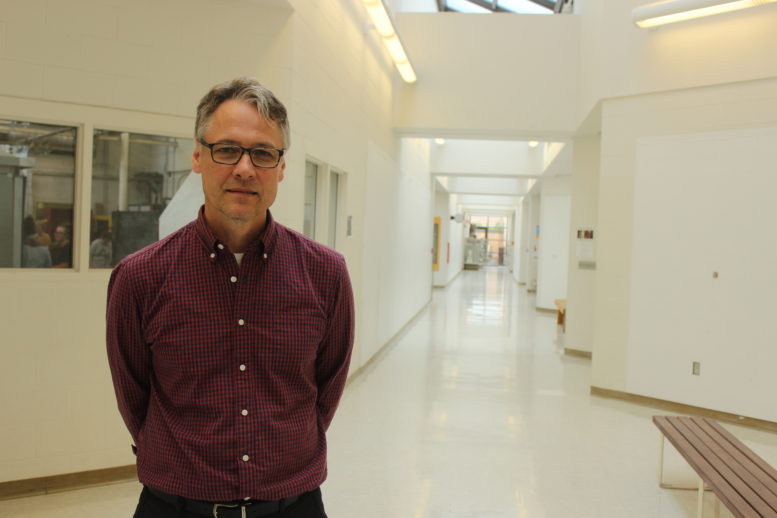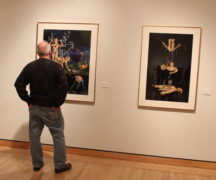By DAVID DUPONT
BG Independent News
Charles Kanwischer steps into his new role as director of the Bowling Green State University School of Art ready draw on ample experience
He assumed the new position in July, taking the reins over from Katerina Ray, who served in that role for 15 years.
Kanwischer, 54, had been associate director for most of Ray’s tenure, and two years ago served as acting director when Ray was on leave. So when Ray announced she would leave the post and join the faculty, Kanwischer said he felt he was prepared for the job.
“Everyone should be so lucky to succeed someone like Katerina,” he said. “The mechanics of the school are in really good shape.”
Having a steady experienced hand will be needed as the School of Art navigates changing currents in the arts.
The School of Art, Kanwischer said, “used to be closed place, focused on its own business of training painters and sculptors. We’ve had to learn to be a more open place while still maintaining that tradition our reputation is based on.”
The school now has new art minors open to student from around campus, and it has removed some prerequisites to introductory studio classes.
That also means developing programs in digital arts and graduate programs aimed at working professionals that blend online and studio work.
This year, the school will offer a Master of Arts in art education, building on its successful art education program. Students, mostly working teachers, take courses online, and then in the summer come to campus for studio work.
Next year, the school will launch a Master of Fine Arts in Graphic Design with a similar format. These both fall in line with the university’s push to create professional graduate programs that attract tuition-paying older students.
Another trend is for better collaboration among the arts units on campus. This strategy was initiated by Dean Raymond Craig, of the College of Arts and Sciences.
The first fruit of this initiative likely will be an integrated media arts program that would bring together elements from art, creative writing, theater and film, and music. The program would be centered on gaming and virtual reality.
The development is in the early stages, Kanwischer said, but “we’d like to do it.”
He sees it as “the next stage in the evolution of our digital arts offerings.”
Also being considered in a program in graphic novels.
Digital arts and graphic design, two applied programs, are responsible for much of the enrollment growth. Traditional studio disciplines have steady enrollment, though the quality of students is “stronger than ever.” Arts education enrollment has rebounded. Kanwischer noted that every graduate of arts education who completed student teaching landed a job.
“It speaks to a central tension of what it means to run an arts school now,” he said. “How do we preserve and extend and make viable the traditional arts at the same time we’re acknowledging the need to stay relevant in terms of technology? It’s tough to work at both ends of the spectrum. Both are expensive. We need to find innovative ways to support that across that whole spectrum.”
He continued: “We think it’s important that a student who comes to study digital technology has some significant experience with analog or physical material, what you might call the friction-based material, the stuff that resists. At the same time we want them to be working with the state of art technology.”
This creates a hybrid art, he said. Students do not doggedly stick with one discipline during their entire college career, he said.
But, Kanwischer said, the school is not about to go blindly chasing after the newest thing. “We don’t want to be completely driven by fashion and or the latest trends,” he said. “We want to be able to analyze an opportunity and decide whether or not it’s right for us. If it is, then we pursue it wholeheartedly and give it all the energy we can.”
He continued: “What I’d like to do is preserve the viability of those traditional programs and at the same time sponsor innovation inside the school. Our first priority is graduating a student who has the opportunity to participate in the cultural conversation. ‘Relevance’ is a keyword. Our programs need to be relevant and prepare students, when they leave here whether in fine art or a more applied art, to participate in that conversation.”
Kanwischer joined the BGSU faculty in 1997 after teaching for six years at Amherst College in western Massachusetts. He received his training in painting and printmaking at the University of Iowa and Yale University.
As director, Kanwischer will continue to teach one class a year. This semester he is teaching intermediate drawing. The choice of an intermediate, rather than advanced course, is intentional. “A couple years ago I recommitted to teaching at an earlier level of the process. I wanted to be closer to the beginning level, getting students who are new to the studio, and just trying to find their own voices.”
Kanwischer also continues to create his own work. He is an award winning artist known for his intricate, closely observed drawings of everyday scenes. He puts in several hours in the studio every morning before coming to the office.
Continuing his studio practice, like teaching, “keeps me grounded.”
“It helps me remember why we do all this.”





